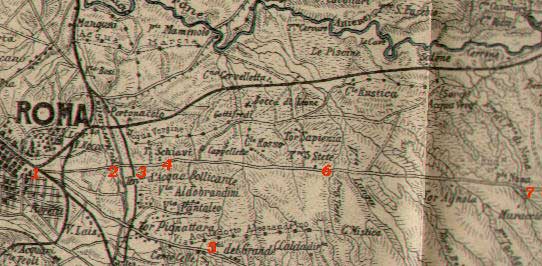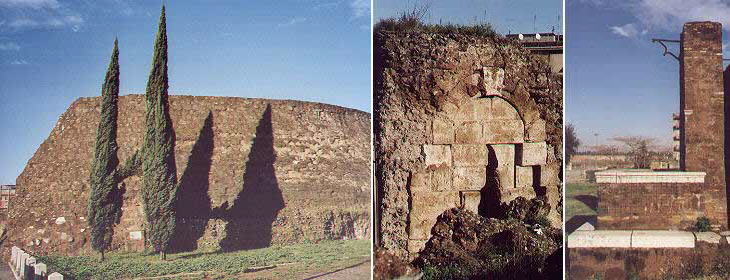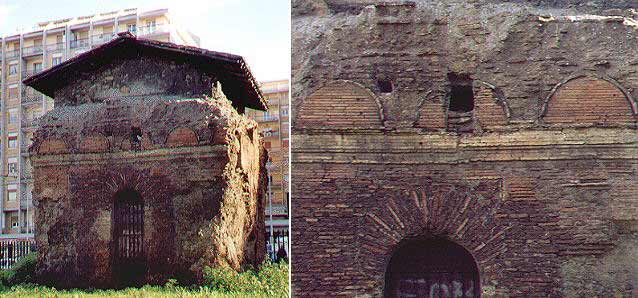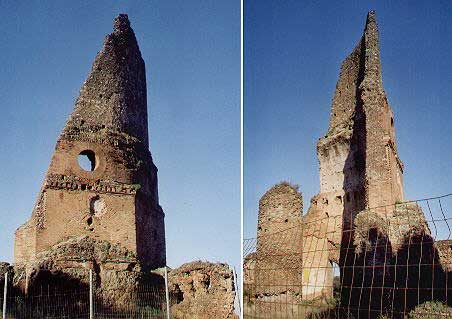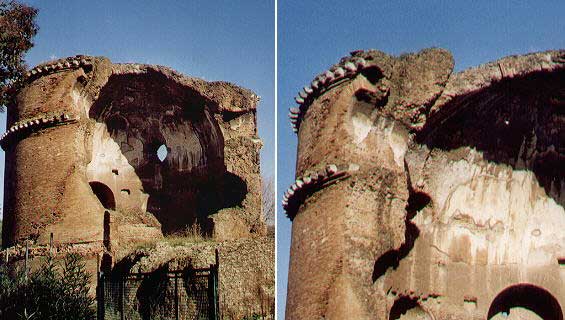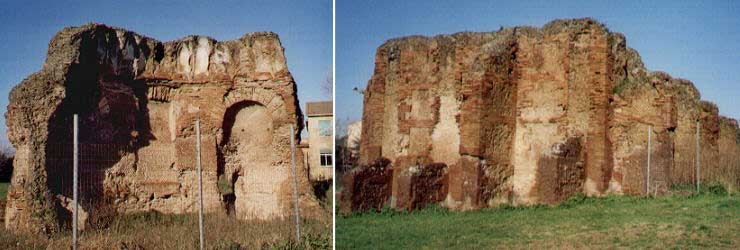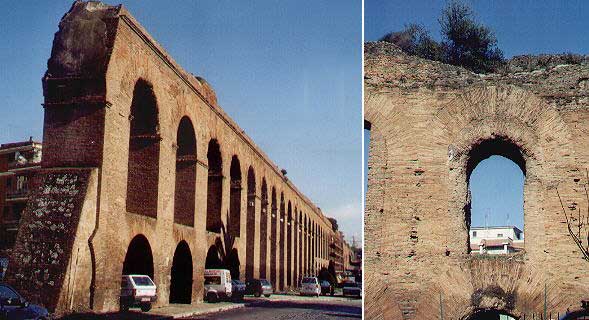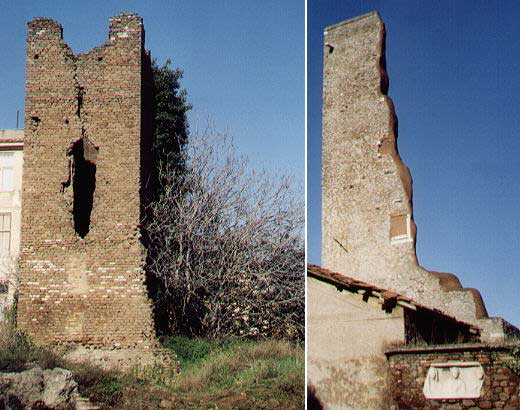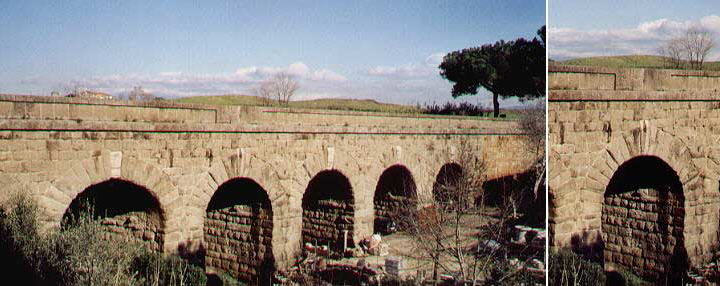  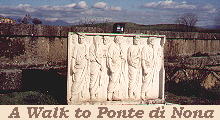 A Walk to Ponte di Nona A Walk to Ponte di Nona
(copy of a Roman relief found near Ponte di Nona)
This walk starts from Porta Maggiore and it follows Via Prenestina, the ancient Roman road
leading to Preneste (Palestrina). Soon after the fall of the Roman Empire the road
was abandoned and it was reopened only in the second half of the XIXth century. The large expansion of Rome
after World War II was mainly directed towards the east and today the initial stretch of Via Prenestina is a highly populated area and some of the monuments shown in this page
are in the middle of tall blocks of flats. The map here below was printed at the beginning of the XXth century and the numbers show the location
of the monuments.
Il Torrione
Via Prenestina was less important than other Roman roads such as Via Appia or Via Aurelia, nevertheless some wealthy Romans chose it to erect their tombs. They were most likely the owners of some land in the area or they had possessions in or came from Preneste. A very large tomb still survives at the second mile of Via Prenestina. A circular wall protects the actual tomb, which, because of its vague resemblance to a tower is called il Torrione. The walls were incorporated into a medieval building. A nearby well was decorated with fragments of the tomb reliefs. The tomb is thought to have been built in the Ist century A.D., because of its similarity with the tomb of Cecilia Metella.
Largo Preneste
Largo (square) Preneste is the center of a very busy and congested borough of Rome. A little Roman tomb made of brickwork and shaped like a temple is the totally out of context embellishment of Largo Preneste. The building was used for centuries as a house or a granary and small windows were opened in the thick Roman walls. Tor de' Schiavi
At the third mile of Via Prenestina a little park provides a more appropriate setting (than Largo Preneste) for a wide array of Roman buildings. The area is known as Tor de' Schiavi (slaves), but it has nothing to do with slavery. The name comes from Vincenzo Rossi dello Schiavo who acquired the buildings and the nearby land in 1571. The tower was built in the Middle Ages on top of a Roman building, an octagon covered by a circular vault which most likely was part of a bath complex. The cylindrical wall at its center supported the steps leading to the top of the medieval tower.
The park is named Villa dei Gordiani after the Roman emperors Gordianus I, Gordianus II and Gordianus III who ruled from 238-244 A.D. and had a large estate in the area. The main building however was erected later on, at the beginning of the IVth century A.D. We still do not know to whom the large circular tomb was dedicated. The fall of part of it shows how the Roman architects designed a vault which got progressively thinner to reduce the pressure on the supporting walls. The building was for a certain period used as a church and the vault has some faint traces of frescoes.
The existence of a large bath complex is proved by several cisterns which stored a large supply of water. Acquedotto Alessandrino
Let's assume a century ago, a traveller along Via Prenestina would have seen at a distance of a mile the impressive arches supporting the aqueduct built by the emperor Alexander Severus (222-35 A.D.) at the point where it crossed a little stream (Fosso di Centocelle). Today the stream is not made of water, but of cars because the stream has been covered by one of the largest avenues of contemporary Rome (Via Palmiro Togliatti). Tor Tre Teste
The landscape of the Roman Campagna until the beginning of the XXth century was characterized by Roman aqueducts and by medieval towers, often built on top of Roman tombs. Tor Tre Teste (three heads) is named after the Roman funerary relief which once was walled at its bottom. Ponte di Nona
At the IXth mile Via Prenestina steps across a brook by a 125 meters bridge built in the Ist century B.C.. Ancient Romans had a penchant for designing straight line roads and to achieve this result they were often uncompromising. Nevertheless when one sees the small stream below the bridge (even assuming it had been broader 2000 years ago), the decision to build such a large bridge can only be justified by the policy of public works which both the Roman Senate and the emperors put in practice to keep the Roman plebs busy. A similar policy was followed by the popes: Clemens XI used to justify the expense for new churches, fountains, etc by saying: E' tutta beneficenza! (it's all charity!). Bibliography for this page: Prof. Alberto Manodori and Giuseppina Pisani Sartorio - Via Prenestina in Roma Archeologica Elio de Rosa Editore 1999. some other walks: Walks with Ferdinand Gregorovius in the Roman countryside In and about Viterbo In Maremma A Pilgrims' Way On the Edge of the Marsh Around Monte Cimino From Civitavecchia to Civita Castellana From Bracciano to Viterbo Anticoli Corrado, where the painters found their models A walk to Porta Furba Via Appia Antica from Cecilia Metella to Torre in Selci Via Appia Antica from Torre in Selci to Frattocchie Branching off Via Cassia: S. Maria di Galeria, Isola Farnese and Formello A Walk to Malborghetto  or to
The Coats of Arms of the Popes or
to My Home Page on Baroque Rome or to
My Home Page on Rome in the footsteps of an XVIIIth century traveller or to
The Coats of Arms of the Popes or
to My Home Page on Baroque Rome or to
My Home Page on Rome in the footsteps of an XVIIIth century traveller
|
All images © 1999 - 2003 by Roberto Piperno. Write to romapip@quipo.it
